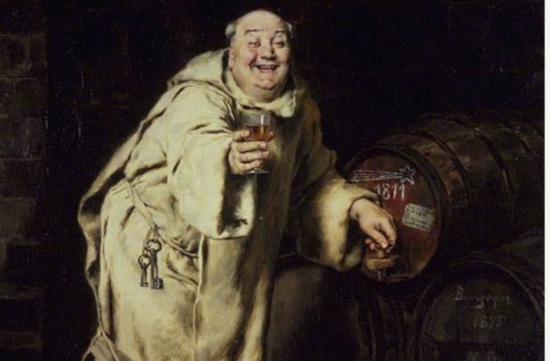
A vigorous world trade in wine had existed for perhaps a thousand years when the western Roman Empire collapsed and cities, key hubs of both mercantile organization and of customers keen for the product, fell into decline and decay.
Late classical civilization didn’t disappear utterly, but was dealt a severe blow. As a new order gradually took shape, the primary surviving institution capable of, and eager to, transmit the old values and its cosmopolitan, literate culture was the Roman Catholic Church — via one of its more remarkable and effective innovations: the monastery.
Benedict of Nursia (480 – 547) was the original mover and shaker. Founder of what became known as the Benedictine order and author of its famous Rule. Celebrated as much for its reasoned, practical program for governing a community of zealous celibates as for its balanced regimen of devotion and hard physical work, the Rule has served as a model for well-ordered Christian monastic communities ever since.
The marriage of prayer and labor (ora et labore, in Latin) is of particular importance for our purposes here, since the Benedictine approach has been vital for the propagation of the wine vine and for winemaking as a commercial enterprise in European history. It was all — to be frank — nakedly transactional and mercenary.
Monks needed land on which to establish their abbey with all its necessary elements (kitchens, refectories, dormitories) and to grow their food. But how was land, at that time wholly in the possession of powerful feudal lords and their vassals, to be acquired?
The answer is that monastic communities had something important to offer in trade for what they needed. By their prayers, masses and good works, the community might intercede with God on behalf of wealthy, land-rich benefactors, for the repose of their souls and early release from medieval Christianity’s halfway house of the afterlife, known as purgatory.
The vehicle for such transactions was the pious bequest, by which land was transferred to the community in exchange for such services. It was primarily by this means that monasteries and their orders (Benedictines, Cistercians, Augustinians, etc.) gradually came into possession of enormous tracts of vineyard land, which they were free to work themselves, lease, sharecrop or sell — and by this means became astonishingly wealthy themselves.
A key part of the story is the degree to which the Church was then uniquely positioned, by virtue of its literate, cosmopolitan character, record-keeping skills, available capital and inter-order chains of communication, to bring wine and winemaking to a pitch of quality it had never known and establish benchmarks of connoisseurship still in use today.
The story of how modern wine took the shape it has today is a long one with many a turning. But isn’t it charming to think it may have all begun with a prayer?